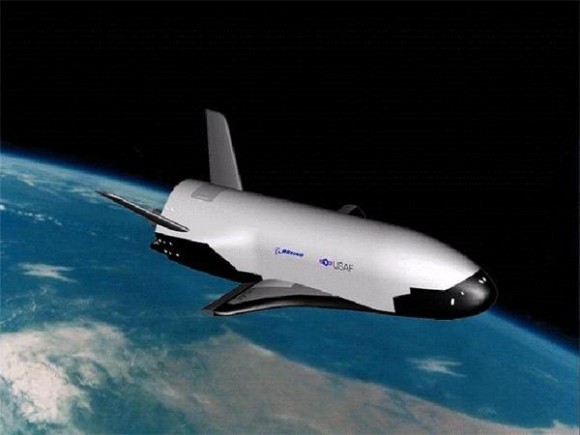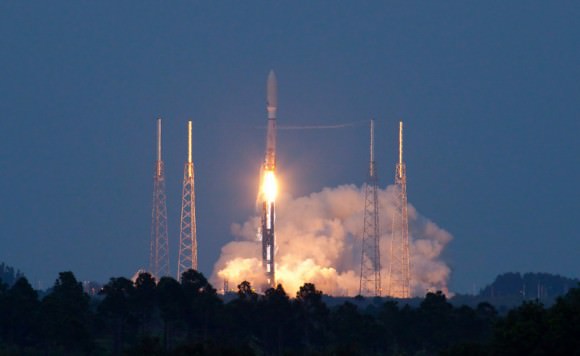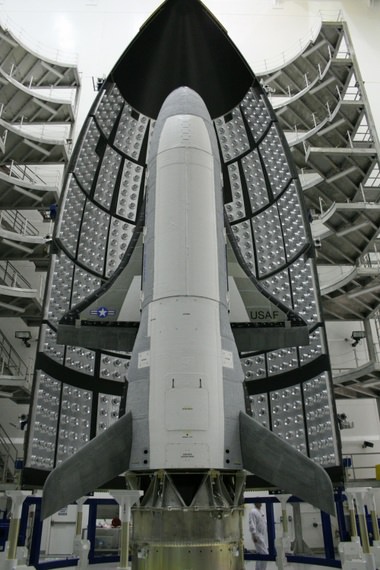[/caption]
Last month’s launch of the US Air Force X-37B secret mini space plane has fueled speculation about the real mission of this vehicle and if it could possibly be used for a new type of military weapon. The X-37B launched on April 22, 2010 and has the ability to stay in orbit for up to 270 days. While the Air Force provided a webcast of the launch, since then there has been no word — leaked or official – about the status of the mission. “There has been a lot of speculation about what this vehicle could do and what sort of capabilities it could provide to the U.S. military, and some of that speculation was based on more science fiction than fact,” said Brian Weeden from the Secure World Foundation. “While a successful completion of the X-37B flight, landing, and turn-around will certainly be a significant step forward in reusable space vehicle technology, it is a long ways away from a single-stage-to-orbit capability.”
Weeden has put together a fact sheet on the X-37B, looking at the technical feasibility of some of the proposed missions for the mini space shuttle look-alike, and says that there’s almost no chance it could be used as a new weapon or a new weapon delivery system.
The X-37B will land unpiloted at Edwards Air Force Base in California. It uses solar arrays and lithium ion batteries to generate power instead of fuel cells like the space shuttle, a major reason why it can stay on orbit for much longer.

Weeden said that after looking at all the proposed missions for the X-37B, he concluded the most likely probability is that it will be used as a flexible, responsive spacecraft to collect intelligence from space and as a platform to flight test new sensors and satellite hardware.
“One of the downsides to using satellites for collecting intelligence is that once they are launched they have a fixed set of sensors and capabilities,” Weeden said. “The X-37B brings to space the capability to customize the on-board sensor package for a specific mission, similar to what can be done with U.S. reconnaissance aircraft such as the U-2 and SR-71. In many ways, this gives the X-37B the best of both worlds,” he added.
Here’s a brief look at the potential uses for the X-37B:
On-orbit sensor platform and test bed, with the ability to return payload. “What it offers that we have seldom had is the ability to bring back payloads and experiments to examine how well the experiments performed on-orbit,” said Gary Payton, the undersecretary of the Air Force for space programs. “That’s one new thing for us.”
Given the R&D that likely was put into the X-37B, this approach probably isn’t very cost-effective, but Weeden said this is the most likely use the spaceplane. X-37B payload bay could hold various sensors used for intelligence collection of the Earth from space, potentially including radar, optical, infrared, and signals/electronic intelligence suites to flight-test and evaluate new sensors and hardware.
Deployment platform for operationally responsive space satellites. Weeden said this has a midrange chance of being X-37B’s mission, and he quotes Payton: “We could have an X-37 sitting at Vandenberg or at the Cape, and on comparatively short notice, depending on warfighter requirements, we could put a specific payload into the payload bay, launch it up on an Atlas or Delta, and then have it stay in orbit, do the job for the combatant commander, and come back home. And then the next flight, we could have a different payload inside, maybe even for a different combatant commander.”
But given it still would be dependent on the availability of EELV, it may not have a very quick response time for launch.
On-orbit repair vehicle. Weeden said this option has a fairly low chance of being X-37B’s real mission. While it could be used to rendezvous with malfunctioning satellites and repair or refuel them, the X-37B is limited in altitude (it has been rumored that it will have a maximum altitude range of 700 or 800 km (about 500 nautical miles), potentially high enough to access most Sun-synchronous satellites, but this is unconfirmed, plus not many existing operational military satellite components will fit in the X-37B cargo bay. And as the engineers who tried to figure out how to fix the Hubble Space Telescope robotically, without humans, on-orbit repair is extremely difficult, if not impossible.

On-orbit inspection of satellites. This option has a low potential, as well. The X-37B could be used to rendezvous and inspect satellites, either friendly or adversary, and potentially grab and de-orbit satellites. However, the X-37B cargo bay is much smaller than many operational satellites, and most of the space in the bay is likely to be filled by the required robotic arm and other gear.
Conventional Prompt Global Strike (CPGS) weapon or delivery system. Weedend says that chance of this being X-37B’s mission is zero. It could be launched in response to a pending crisis and remain on orbit for a length of time to respond to high value/very time sensitive targets. However, since the X-37B re-enters like the space shuttle and lands at an estimated 200 mph (321 kph), this means it travels in the atmosphere much slower than a ballistic arc or a hyperkinetic weapon, so it would need to carry conventional explosives to do any significant damage. Also, after re-entry would be a slow moving, not-very-maneuverable glide bomb, easy prey for any air defense system along its path to the target.
For more information, a four-page, fact-filled X-37B Orbital Test Vehicle Fact Sheet is now available on Secure World Foundation’s website.
Source: Secure World Foundation, special thanks to Leonard David.


Wouldn’t it be advantageous to have a closer look at the Chinese orbiters? Especially if the observing *.sat were ‘stealthy’ i.e. has a low observable radar profile?
What about the possibility that the mini orbiter would rendezvous with another satellite and then simply (magnetically?) attach a small listening device (bug) to say a narrow beam antenna?
Aren’t there international treaties against the weaponisation of Space?
The use of the X-37B as a sensor platform and test bed seemed the most likely mission to me. Custom sensor suites for whatever global hotspot would be highly advantageous for military planners. Repair of faulty sensor packages or updating sensors with the latest technology is something you just can’t do with a Keyhole satellite, for instance. It is interesting to see how other mission possibilities played out in this analysis.
“Treaties?! Vee spit on ze treaties!”
Outer Space Treaty:
“The Outer Space Treaty represents the basic legal framework of international space law. Among its principles, it bars States Parties to the Treaty from placing nuclear weapons or any other weapons of mass destruction in orbit of Earth, installing them on the Moon or any other celestial body, or to otherwise station them in outer space. It exclusively limits the use of the Moon and other celestial bodies to peaceful purposes and expressly prohibits their use for testing weapons of any kind, conducting military maneuvers, or establishing military bases, installations, and fortifications (Art.IV). However, the Treaty does not prohibit the placement of conventional weapons in orbit.”
D’oh! OK, I guess everything is in order then. (o.O)
Oh, and since IVAN3MAN hasn’t shown up yet: I believe Mr David may be interested to know that the fact sheet refers to a “Center upper stage”, which I believe should refer to that old work horse, a Centaur upper stage.
It could also tug a satellite to another place and maybe bring something back to Earth.
I don’t find this little thing particularly interesting in and of itself (its too small and limited), but I’m curious as to what the US military is going to do with their next prototype in this same line, if there is one.
I assume that their eventual goal is a Single Stage to Geostationary Orbit fully reusable vehicle with a post-mission turnaround time of a few days. And probably someone a bit larger than this, too.
They’re a long, long way from that though, unfortunately:(.
gopher65, I too think long term goals may be along those lines, if they want to take it further.
But the interesting deed is already done, military tactics and vehicles are separated from civilian.
Short term benefits are the potential lack of sub-optimization and cost rise seen in the Space Shuttle system, and the increased opportunity for international cooperation on civilian projects.
Long term benefits would be exactly the opportunity for commercial companies to develop cost effective technologies such as reusable parts or crafts. That is now guaranteed to happen, instead of relying on risky and costly agency “strategic development”.
The US “space gap” broke the previous mold of “everything in one packet, never mind the costs and risks”. Finally the gears, nay pump turbines, are starting to work on this here thing called “space exploitation”!
Weeden seems to have missed that this thing is of a size that it could sit on top of a Minuteman in a silo with little mods. (Warheads removed for example) Decomissioned Minuteman bodies have been proposed as a launch vehicle before.
I am curious, do military have to pay for patents when using the Space shutttle technology?
Likely, the USAF is testing the capabilities and manuverability. Which could take up to 3 months.
Servicing and refueling intel satellites, which are typically in low Earth orbit would be a very good job for this little guy. It could also be used to increase the orbit of a satellite which has gotten just a bit too low for comort. Something which happens quite a bit when the Sun gets crazy and the atmosphere expands.
I could see future LEO satellites being designed to be serviced by the X-37, or a similar space craft. It would greatly increase the life span; and if it could refuel satellites, we wouldn’t have to have as many in orbit. Which means the X-37 would pay for itself, out of its capabilities alone.
It is to place eavesdropping equipment on satellites. Remember when spooks in subs placed equipment next to undersea communication lines to listen in? They worked by induction, so no lines had to be cut.
Same thing with the X-37b. Maybe sats could be electronically hijacked as well in time of need.
PS – Treaties don’t apply to secret stuff.
It’s International Rescue’s Thunderbird 6!!
RUF
The craft would have to be very stealthy in order to move in on another satellite (may be a capability, I don’t know), since Russia and China both have RADAR capability to watch satellites. If they have the capability to use IR to zoom in on satellites (likely they do), then stealth avoidance material wouldn’t matter.
As far as listening in, we can already do that, since the satellite would have to send radio transmissions back to Earth. However, any important transmissions will be encrypted.
Olaf…
This item is contracted to be built by Boeing. Any patent they use, they would have to pay for. Knowing this, they would have added these costs into the contract with the government.